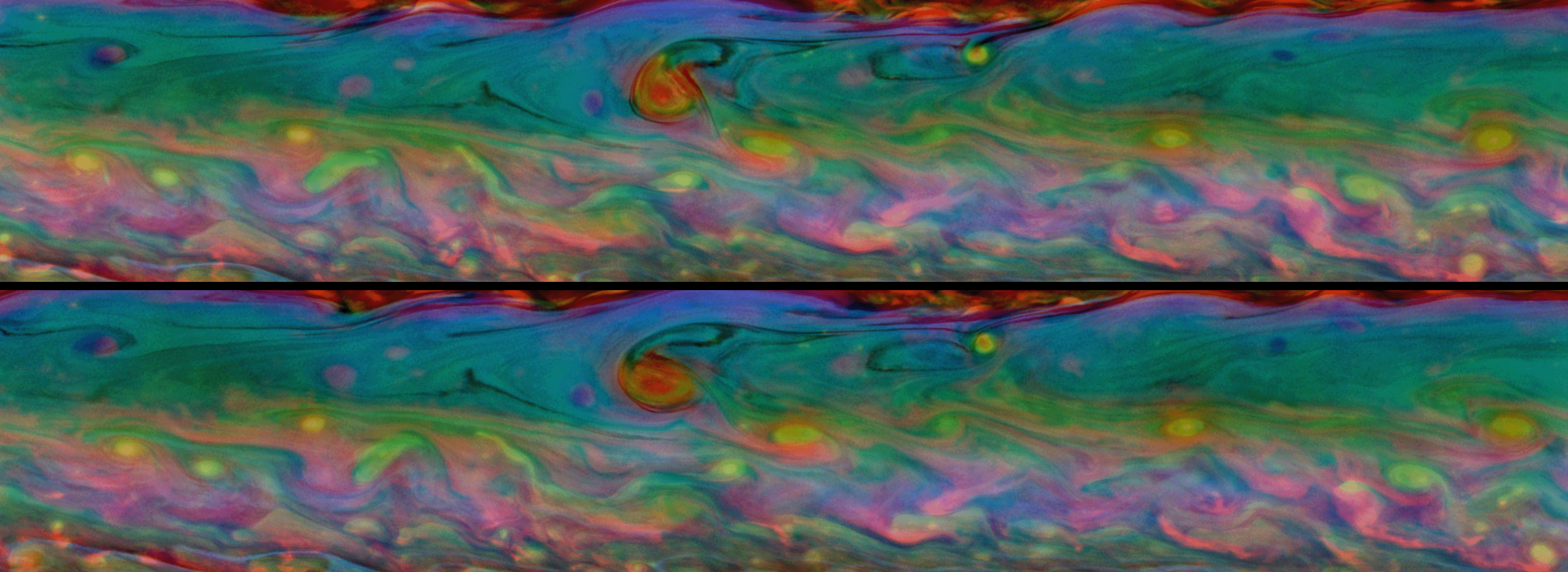
|
Churning Psychedelia
- Click the image above for a larger view
 Movie Download Options
Movie Download Options- Full-Res JPEG (4931 x 1800) (737.6 kB)
- Full-Res TIFF (4931 x 1800) (26.6 MB)
Caption:

Two-Frame Animation
Click on the image for the animation
These two false-color views from NASA's Cassini spacecraft show detailed patterns that change during one Saturn day within the huge storm in the planet's northern hemisphere.
Taken about 11 hours -- or one Saturn day -- apart, these mosaics consist of 48 images each. The top mosaic was taken earlier than the bottom mosaic. Both mosaics were captured on Aug. 7, 2011, and each of the two batches of images was taken over about 2.5 hours.
A two-frame animation is also included here, scaled down from the full-size mosaics. The animation switches back and forth between the two mosaics allowing comparisons of the subtly changing cloud details. Several features in the more southern part of the storm can be seen moving to the right, or east, while several features in the more northern part of the storm can be seen moving to the left, or west.
Cassini scientists study the fine details contained in these mosaics to learn about wind speeds and cloud depths in the storm. For example, a red curlicue that indicates a deep cloud present when the top mosaic was captured may not appear or may have moved in bottom mosaic taken 11 hours later.
See PIA14903 for similar, false-color mosaics captured in February 2011.
These views look at a more southerly latitude on Saturn than the earlier mosaics in PIA14903, and these views are better centered on the storm. Whereas those earlier false-color mosaics appear more blue-green because they show more of the area surrounding the storm, these false-color mosaics show the many colors of the storm itself.
Both mosaics cover an area ranging from about 21.8 degrees north latitude to 38.7 degrees north latitude. The views stretch from about 233.3 degrees west longitude on the right to 318.3 degrees west longitude on the left.
See PIA14906 to learn more about the development of this storm.
The images were taken with the Cassini spacecraft narrow-angle camera using a combination of spectral filters sensitive to wavelengths of near-infrared light. The images filtered at 889 nanometers are projected as blue. The images filtered at 727 nanometers are projected as green, and images filtered at 750 nanometers are projected as red.
The views were acquired at a distance of approximately 1.5 million miles (2.4 million kilometers) from Saturn and at a sun-Saturn-spacecraft angle (phase angle) of 33 degrees. Both the top and bottom images are simple cylindrical map projections, defined such that a square pixel subtends equal intervals of latitude and longitude. At higher latitudes, the pixel size in the north-south direction remains the same, but the pixel size (in terms of physical extent on the planet) in the east-west direction becomes smaller. The pixel size is set at the equator, where the distances along the sides are equal. The images have a pixel size of 11 miles (18 kilometers) at the equator.
Background Info:
The Cassini-Huygens mission is a cooperative project of NASA, the European Space Agency and the Italian Space Agency. NASA's Jet Propulsion Laboratory, a division of the California Institute of Technology in Pasadena manages the mission for NASA's Science Mission Directorate, Washington. The Cassini orbiter and its two onboard cameras were designed, developed and assembled at JPL. The imaging team is based at the Space Science Institute, Boulder, Colo.
For more information about the Cassini-Huygens mission, visit http://saturn.jpl.nasa.gov and the Cassini imaging team home page, http://ciclops.org .
Cataloging Keywords:
| Name | Value | Additional Values |
|---|---|---|
| Target | Saturn | |
| System | ||
| Target Type | Planet | |
| Mission | Cassini-Huygens | |
| Instrument Host | Cassini Orbiter | |
| Host Type | Orbiter | |
| Instrument | Imaging Science Subsystem (ISS) | |
| Detector | Narrow Angle Camera | |
| Extra Keywords | Atmosphere, Color, Infrared, Map, Movie, Storm, Visual | |
| Acquisition Date | ||
| Release Date | 2011-11-17 | |
| Date in Caption | 2011-08-07 | |
| Image Credit | NASA/JPL-Caltech/Space Science Institute | |
| Source | photojournal.jpl.nasa.gov/catalog/PIA14906 | |
| Identifier | PIA14906 | |
